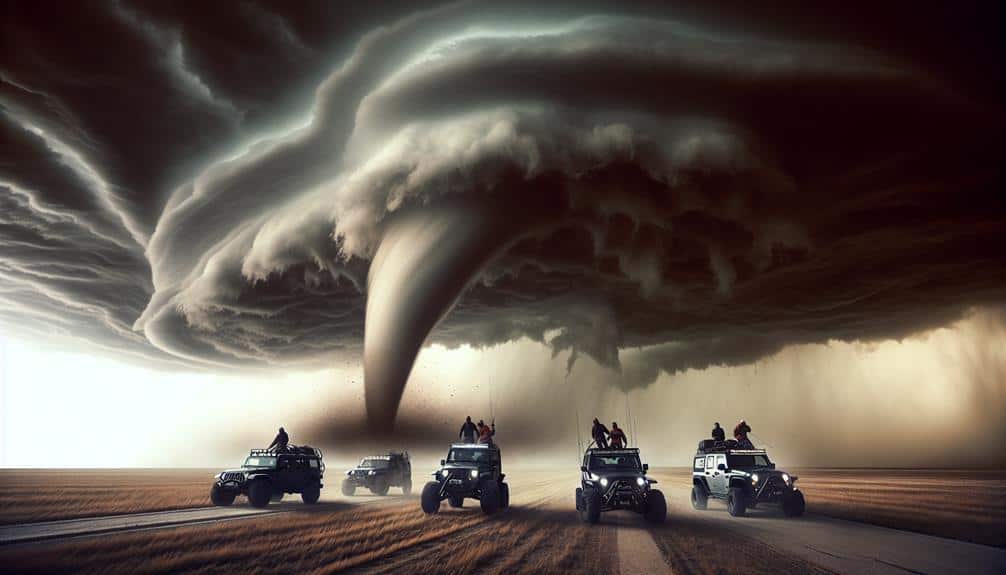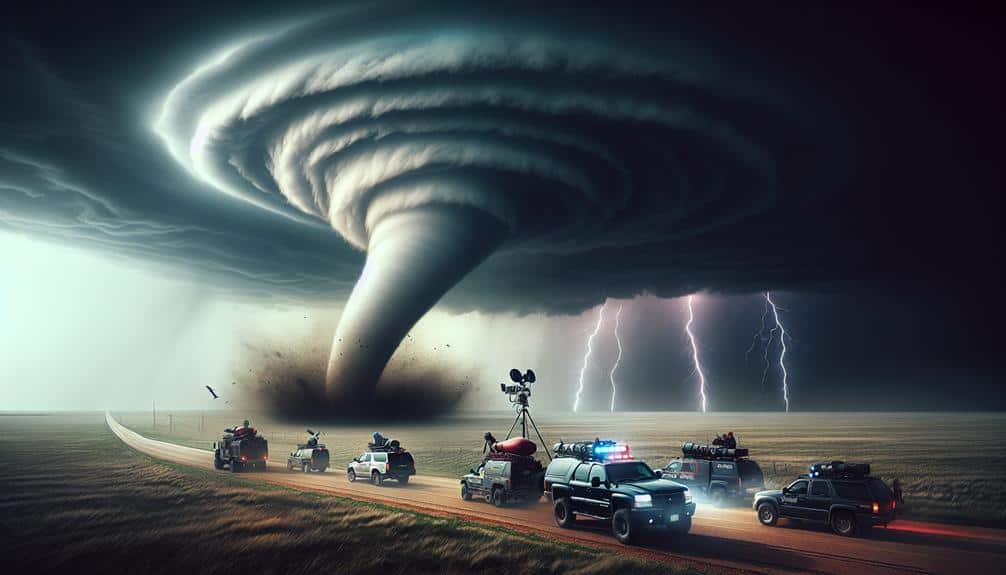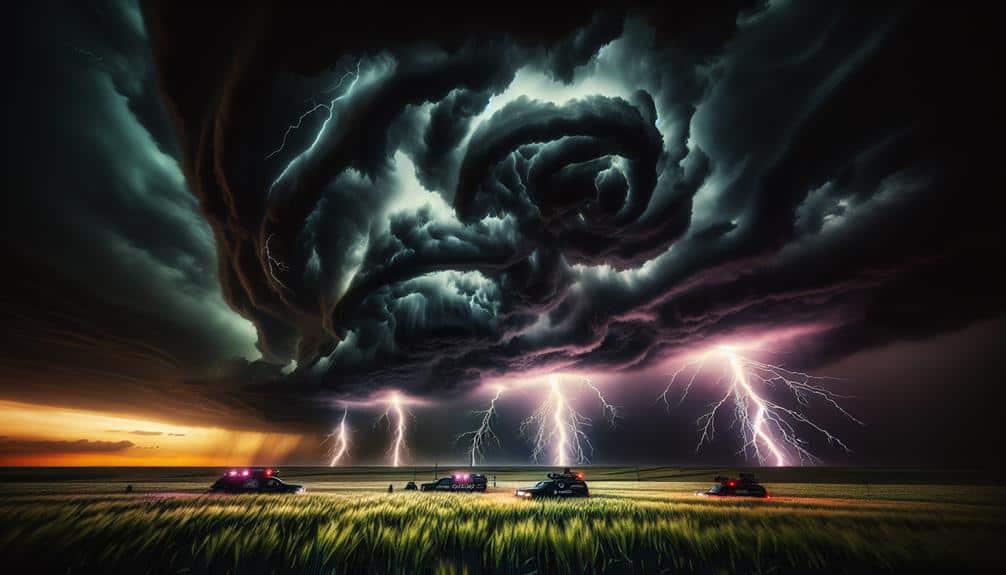In our pursuit of storm chasing, we've identified seven prime events: Tornado Alley Classic, Great Plains Twister Hunt, Dixie Alley Pursuit, Midwest Supercell Showdown, High Plains Vortex Challenge, Gulf Coast Cyclone Chase, and Rocky Mountain Weather Wrangle. Each presents unique challenges like maneuvering through Dixie Alley's dense forests, understanding the High Plains' complex weather dynamics, and accessing rugged Rocky Mountain terrain. Utilizing cutting-edge Doppler radar, mobile mesonets, and high-resolution cameras, we meticulously track atmospheric conditions and tornado genesis. Effective communication, safety protocols, and real-time data integration are crucial. For a deeper insight into overcoming these challenges, keep exploring with us.
Key Points
- Tornado Alley Classic presents frequent severe thunderstorms and tornadoes, requiring advanced tracking and quick decision-making.
- Great Plains Twister Hunt offers ideal tornado observation conditions but demands precise navigation and real-time data analysis.
- Dixie Alley Pursuit involves volatile weather patterns and dense forests, challenging visibility and necessitating careful route planning.
- Midwest Supercell Showdown features high tornado genesis frequency, requiring constant atmospheric monitoring and effective communication.
Tornado Alley Classic
In the heart of the United States, Tornado Alley presents a prime location for storm chasing due to its high frequency of severe thunderstorms and tornadoes. We find ourselves drawn to this region, where weather patterns create perfect conditions for capturing nature's fury.
To effectively chase storms, we've got to be well-prepared with the right equipment essentials. Our arsenal includes Doppler radar units, anemometers, and GPS devices, guaranteeing accurate storm tracking. High-resolution cameras with fast shutter speeds are essential for storm photography techniques, allowing us to document every lightning strike and funnel cloud. Utilizing wide-angle lenses enhances our ability to capture expansive storm structures.
Storm tracking strategies hinge on interpreting weather models and real-time data. We continually monitor atmospheric conditions, focusing on supercell development. Effective communication protocols are crucial; we maintain constant contact via radio and mobile networks to share updates and ensure safety.
Great Plains Twister Hunt
We now focus our storm chasing efforts on the Great Plains, where unique topographical features and climatic conditions create ideal scenarios for observing and analyzing tornado formation. The vast expanse of flat terrain in states like Kansas, Oklahoma, and Nebraska allows us to employ advanced storm tracking techniques, enhancing our ability to predict and follow extreme weather conditions.
Our primary goal is to understand tornado formation by studying supercell thunderstorms, which are prevalent in this region. We use Doppler radar data, atmospheric soundings, and satellite imagery to identify rotation within these supercells. Combining these tools with real-time observations, we can refine our storm chasing strategies, positioning ourselves optimally to witness the birth of tornadoes without compromising safety.
The Great Plains offer an unparalleled laboratory for our research. The predictable patterns of severe weather allow us to deploy mobile mesonets and drones, gathering high-resolution data on temperature, humidity, and wind speed. This data is essential for developing more accurate storm prediction models and enhancing our understanding of the dynamics involved in tornado formation.
Dixie Alley Pursuit
In Dixie Alley, we face significant challenges due to unpredictable weather patterns and the complexity of maneuvering through dense forests. Limited visibility hazards further complicate our efforts, increasing the risk of missing critical data during storm events.
These factors necessitate advanced forecasting models and robust logistical planning to improve safety and data collection accuracy.
Unpredictable Weather Patterns
Exploring Dixie Alley exposes storm chasers to the volatile and highly unpredictable weather patterns distinctive to this region. The unique topography and atmospheric conditions spawn extreme conditions that challenge even the most experienced storm chasers. With frequent severe thunderstorms and rapid tornado formation, expert guidance is essential. We rely on real-time data from Doppler radar, satellite imagery, and mesoscale models to anticipate these extreme weather events accurately.
Weather unpredictability in Dixie Alley requires stringent safety protocols. We must continuously monitor atmospheric instability, wind shear, and moisture convergence to assess tornado potential. Real-time adjustments to our chase strategies are vital, as conditions can evolve rapidly, often without clear indicators. Our safety protocols include predetermined escape routes, communication plans, and emergency shelters, making sure we can respond swiftly to unexpected developments.
The thrill of storm chasing in Dixie Alley lies in its unpredictability, yet it demands careful planning and unwavering vigilance. By adhering to scientific rigor and utilizing advanced meteorological tools, we navigate this dangerous terrain with a balance of caution and daring. As we pursue nature's fiercest phenomena, our dedication to safety and precision guarantees that we can continue to chase the storm, not the other way around.
Traversing dense forests in Dixie Alley demands acute situational awareness and precise coordination due to the limited visibility and challenging terrain. We need to employ advanced wilderness survival techniques to guarantee our safety and efficacy in storm chasing. The dense canopy and underbrush impede our line of sight, making tree navigation an indispensable skill.
We utilize GPS technology and topographical maps to chart our path, but these tools are only as reliable as our ability to interpret them in real-time.
In Dixie Alley, we're not just contending with meteorological phenomena but also the intricacies of forested landscapes. The dense foliage means we must consistently communicate to avoid physical obstructions and navigate unpredictable terrain.
Data show that the frequency of tree falls and dense undergrowth increases the risk of vehicular immobilization, necessitating prompt problem-solving and mechanical proficiency.
Our strategy involves pre-mapping potential egress routes and maintaining a dynamic awareness of our surroundings. We also carry essential survival gear—first aid kits, water filtration systems, and emergency communication devices—to mitigate risks.
Limited Visibility Hazards
Limited visibility during storm chasing in Dixie Alley poses significant risks and challenges. The dense foliage, frequent rain, and foggy conditions make it difficult to navigate and observe storm patterns accurately. To mitigate these dangers, our team relies on advanced radar systems, night-vision cameras, and high-lumen portable lights for enhanced visibility.
In addition to equipment preparation, effective communication strategies are crucial for our operations. Utilizing radio communication, GPS tracking, and live data feeds allows us to maintain constant contact and coordinate our movements. This ensures that all team members are aware of each other's positions and the evolving weather conditions.
Implementing these tools and strategies not only reduces the risk of accidents but also enhances our ability to gather accurate storm data. Double new line has been added to separate the concepts for better readability.
Midwest Supercell Showdown
In the Midwest, supercells present a unique challenge for storm chasers due to their high frequency of tornado genesis and the rapid development of severe weather conditions. Our storm tracking strategies must be precise and adaptive. We rely on Doppler radar data and atmospheric models to anticipate tornado formation.
The extreme weather risks are significant, demanding that we stay vigilant and flexible, ready to reposition at a moment's notice.
Understanding the dynamics of supercells is essential. These rotating thunderstorms can produce large hail, damaging winds, and tornadoes. The mesocyclone, a rotating updraft within the storm, is the key feature we monitor. Our storm tracking strategies involve triangulating data from multiple sources, including satellite imagery and ground-based observations.
When it comes to equipment essentials, we can't afford to compromise. High-resolution GPS units, mobile data hotspots, and anemometers are just a few of the critical tools.
For storm chasing tips, always have a reliable vehicle, maintain situational awareness, and never underestimate the storm's potential.
High Plains Vortex Challenge

The High Plains Vortex Challenge presents storm chasers with a unique set of difficulties, primarily due to the complex interplay between dryline boundaries and low-level jet streams. These meteorological phenomena create an environment ripe for extreme weather events, but they also introduce significant variability in storm tracking. By understanding the dynamics at play, we can better anticipate these volatile circumstances.
Dryline boundaries, which separate moist air from dry air, often act as the ignition point for severe thunderstorms. When combined with low-level jet streams, which transport warm, moist air from the Gulf of Mexico, the result is a highly unstable atmosphere conducive to the formation of tornadoes and supercells. This interplay requires us to be constantly vigilant and adaptive in our storm tracking efforts.
To navigate these challenges effectively, we need to focus on:
- Real-time Data Analysis: Accessing and interpreting live radar and satellite data is essential for making split-second decisions.
- Advanced Forecasting Models: Utilizing predictive models helps us anticipate storm path and intensity changes.
- Field Coordination: Effective communication with team members on the ground ensures that we can respond swiftly to evolving circumstances.
Gulf Coast Cyclone Chase
In our Gulf Coast Cyclone Chase, we encounter unique weather patterns driven by the warm Gulf waters and varying atmospheric conditions.
These events demand rigorous safety precautions, given the rapid intensification and unpredictability of tropical cyclones.
Our data collection focuses on accurately tracking storm genesis, wind speeds, and precipitation rates to enhance predictive models.
Unique Weather Patterns
Encountering the Gulf Coast's distinctive cyclone patterns demands a deep understanding of atmospheric dynamics and real-time data analysis. The Gulf Coast, a hotspot during hurricane season, is characterized by intense cyclonic activity influenced by sea surface temperatures and atmospheric pressure gradients. These conditions create a diverse range of storm behaviors, from rapid intensification to erratic path deviations.
We need to harness advanced meteorological tools to decode these patterns. Real-time satellite imagery, Doppler radar systems, and high-resolution weather models are indispensable in predicting the trajectory and intensity of these cyclones. The Gulf Coast's interplay with monsoon madness further complicates these predictions, as moisture-laden air masses merge with cyclonic systems, often producing unforeseen weather phenomena.
Our approach to understanding these unique weather patterns involves:
- Data Integration: Combining satellite data, ground-based observations, and numerical models to generate thorough weather forecasts.
- Pattern Recognition: Identifying recurring atmospheric signatures associated with rapid cyclonic development and path alterations.
- Dynamic Analysis: Continuously updating our models with real-time data to refine predictions and adapt to evolving storm behavior.
Safety Precautions Required
While decoding these complex weather patterns is essential, securing our safety during Gulf Coast cyclone chases demands rigorous preparation and adherence to established protocols. To begin with, emergency preparedness is critical. We must equip ourselves with necessary gear, including first-aid kits, non-perishable food, water supplies, and weather-resistant clothing. These items can be life-saving in unpredictable scenarios.
Vehicle safety is another vital component. Our chase vehicles need to be sturdy, regularly maintained, and equipped with emergency tools like tire repair kits and jump starters. Securing our vehicles are four-wheel drive can enhance maneuverability in challenging terrains and adverse weather conditions.
Communication strategies are indispensable. We use a combination of satellite phones, two-way radios, and GPS tracking devices to maintain constant contact with our team members and local authorities. This redundancy ensures we stay informed about the cyclone's path and any sudden changes in weather conditions.
In addition, we rely on real-time data from meteorological instruments and mobile radar systems to make informed decisions. By integrating scientific accuracy with robust safety measures, we can pursue our passion for storm chasing while minimizing risks and maximizing our freedom to explore nature's most powerful phenomena.
Rocky Mountain Weather Wrangle

Traversing the volatile atmospheric conditions of the Rocky Mountains presents unique challenges for storm chasers, necessitating advanced meteorological tools and real-time data analysis to predict severe weather patterns accurately. The mountainous terrain and extreme conditions amplify the complexity of these pursuits, necessitating a deep understanding of local microclimates and orographic influences.
In these remote locations, unpredictable storms can emerge with little warning, making it essential for us to leverage sophisticated radar systems and satellite imagery.
Here are three vital elements to keep in mind:
- Topographic Influence: The rugged landscape alters wind patterns and can intensify storm development, creating localized phenomena that are challenging to forecast without high-resolution models.
- Access Challenges: Remote locations often lack infrastructure, complicating both monitoring and response efforts. This isolation demands reliable communication and navigation technologies to guarantee safety and effectiveness.
- Data Integration: Combining ground-based observations with aerial and satellite data provides a complete view of evolving weather systems. This multi-faceted approach enhances our ability to forecast and react to rapid changes.
Frequently Asked Questions
What Safety Measures Should Storm Chasers Always Follow?
We should always adhere to safety protocols and establish clear emergency plans. This includes monitoring weather data, maintaining communication, and having a well-stocked emergency kit. Let's prioritize our safety while embracing the thrill of storm chasing.
How Do Storm Chasers Communicate During a Chase?
We use advanced communication methods and technology like radios and GPS to maintain team coordination. Our strategies include real-time data sharing, situational awareness updates, and predefined check-ins to guarantee everyone's safety and effective storm tracking.
What Qualifications Are Needed to Become a Professional Storm Chaser?
Oh, becoming a professional storm chaser isn't just about loving chaos! We need rigorous training requirements, extensive experience, and skills necessary in meteorology. Our education background typically involves atmospheric sciences to guarantee we're not just thrill-seekers.
How Do Storm Chasers Predict the Best Locations for Storms?
We predict the best storm locations using advanced predictive technology and rigorous meteorological analysis. By leveraging high-resolution weather models and real-time data, we identify storm development patterns, maximizing our chances for successful and thrilling storm-chasing experiences.
What Essential Equipment Is Required for Storm Chasing?
For storm chasing, we need camera gear for documentation, reliable vehicle safety systems, radar, GPS, and weather radios. This equipment guarantees we capture data while staying safe and mobile. Freedom to explore relies on preparation and precision.


